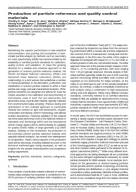Details
- Identification
- ISSN: 1977-5296, DOI: 10.3011/ESARDA.IJNSNP.2019.12
- Publication date
- 1 December 2019
- Author
- Joint Research Centre
Description
Volume: 59, December 2019, pages 29-38,
Authors: Timothy R. Pope1, Bruce W. Arey1, Mindy M. Zimmer1, Michael DeVore II2, Michael G. Bronikowski2, Wendy Kuhne2, Aaron T. Baldwin2, Cristina Padilla‑Cintron1, Norman C. Anheier1, Marvin G. Warner1, Matthew S. Wellons2, and Christopher A. Barrett1
1Pacific Northwest National Laboratory, 2Savannah River National Laboratory
Abstract: Maintaining the superior performance of new analytical instrumentation and pushing the boundaries of eversmaller particle analysis by methods such as secondary ion mass spectrometry (SIMS) has become limited by the availability of certified particle standards for calibration, quality control, and validation. To meet this growing demand for a reliable and universal approach to the generation of uranium particle reference material, the Pacific Northwest National Laboratory (PNNL) and Savannah River National Laboratory (SRNL) are collaborating on a joint venture that establishes a number of chemical pathways to the fabrication, purification, and stabilization of uranium particle material to within a fixed particle size range, and well-characterized isotopics. PNNL particle standards are designed and tailored to meet the criteria essential to the calibration and benchmarking of instruments used in both the non-destructive and destructive assay of particulate material, typically collected from environmental swipe sampling. Previous testing and optimization of this colloidal approach to particulate material has centred on tight size distributions, singular composition and density, uniform morphology, and tailored isotopic abundances. Extensive validation of this material has since been performed, both at the National Institute of Standards and Technology (NIST) and the International Atomic Energy Agency (IAEA), demonstrating its suitability for quality control needs of large geometry (LG)-SIMS analysis. Building on this momentum, the production of low-enriched uranium particle reference material, with specially tailored isotopics, has moved from development to full operation. Herein, various aspects of the production cycle will be discussed, including detailed accounts of the technical methodologies being employed, as well as insights into the sample characterization and acceptance testing requirements.
Keywords: particle; standards; uranium; safeguards, synthesis.
Reference guideline:
Pope, T.R., Arey, B.W., Zimmer, M.M., DeVore II, M., Bronikowski, M.G., Kuhne, W., Baldwin, A.T., Padilla-Cintron, C., Anheier, N.C., Warner, M.G., Wellons, M.S., & Barrett, C.A. (2019). Production of particle reference and quality control materials. ESARDA Bulletin - The International Journal of Nuclear Safeguards and Non-proliferation, 59, 29-38. https://doi.org/10.3011/ESARDA.IJNSNP.2019.12

